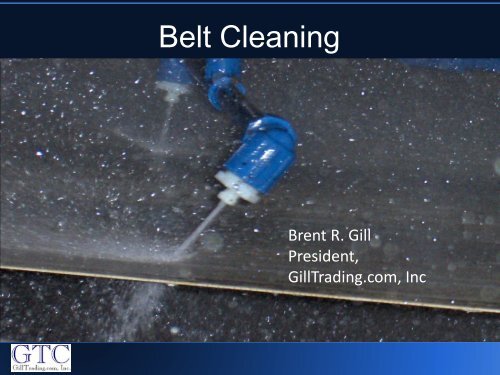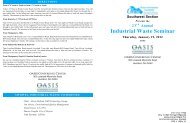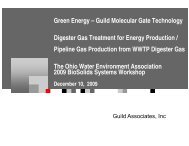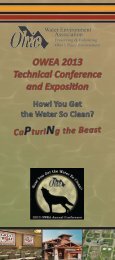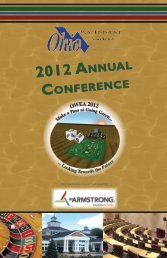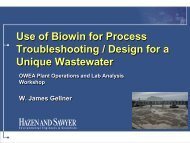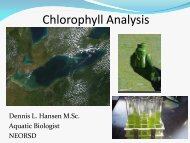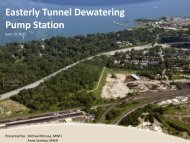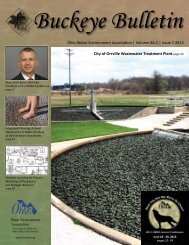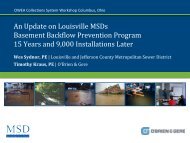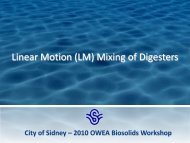You also want an ePaper? Increase the reach of your titles
YUMPU automatically turns print PDFs into web optimized ePapers that Google loves.
<strong>Belt</strong> <strong>Cleaning</strong>Brent R. GillPresident,GillTrading.com, Inc
Gravity <strong>Belt</strong> ThickenerProblem: Cowlitz County:2m <strong>Belt</strong>• Frequent <strong>Cleaning</strong>• Removal and reinstall• 2 year life• Feed Rate not at design• Speed not at design
Visual inspection• Fabric back covered with hardened product
Existing Fan spray
Existing Wash Spray Approach•Nozzles recessed in pipe--difficult to clean•Brushes only temporarily loosen cloggedmaterial to nozzles•Maintenance requires removal of full sprayheader to clean
Strip brush spray cleaner
Washbox design•Current belt cleaning is static•Small nozzle openings•Clogged nozzles difficult toclean•Washing action vs. cleaning•Near zero penetration•Nozzles clogged frequently
Brushes• Brush “pipe cleaner” design• Fouls with particulate• Requires regular dis-assembly to clean
Spray Width vs. cleaning force• Existing fan sprays• Wash belt vs. clean• Little penetration• Usually washesonly one side• Hi-pressure pump• Hi-spray distance
<strong>Belt</strong>/Fabric design parametersFABRIC SPECIFICATIONThickness - ?? mmTensile Strength – ???? N/cmOpening – 0-470u???Air Permeability – ???? l/m2/s ??? P aCFM – ???Safety Factor of <strong>Belt</strong> – ?? @ ??? pliSafety Factor of Seam (standard, L) – ?? @ ??? pliTensile Strength of Seam (standard, L) – 502.8 pli
Fabric design parameters
<strong>Belt</strong>/Fabric design parametersMONOFILAMENT POLYESTERProcess design: Pattern – 6/2, ????Surface - Ultra Smooth, ????Low Modulus-of-ElasticityWarp material – pes, ????Weft material – pes, ????MODIFIED SATIN WEAVE, ????Process design:Mesh/Count/Weave – Optimized, ????CDM – Cross Machine Direction – Large (Diameter), ????
Fabric accelerated deterioration• Fabric fiberdelamination• Fibers createadditional surface areafor polymers andmaterial to precipitate• Fibers accumulatematerial and lay flat infeed/mixing zone
Home-made spray•Existing washbox theory insufficient•Operators forced to design own systems
Gravity <strong>Belt</strong> Pilot Test•2 meter GBT•40 existingnozzles•80 gpm @ 70psi•1/8” of Materialon back of fabric•<strong>Belt</strong> Blaster pilot8 gpm @ 70 psi
<strong>Belt</strong> Blaster- GBT
Rotating Spray Advantages• High impingement forces• Reduced water volume• Reduced pressure• Roll tracking control due to reducedmaterial on rolls• Higher consistent belt cleanliness actuallyremoves material compressed on rolls
<strong>Belt</strong> Blaster System•Optimize washbox system efficiency•Reduce water volume used with improved weavepenetration•Drive materials out of weave openings•Reduce nozzle clogging issues•Consistant weave opening, therefore improveddewatering abilities•Consistant scfm=improved speed
<strong>Belt</strong> Filter Press pilot test•Pilot test available forextreme cases•Adaptable to mostmachine configuration•Bolt in test model•2” strip betweenRotating spray bars=belt normal state
Strainer filtration• 60-300 mesh strainer• Larger diameter due to larger nozzleopenings• Automated cleaning strainer available
Secondary cleaning• Rolls stay cleandue to the beltbeing cleaner• Machine tracking/control systemsreliabilityimproved
<strong>Belt</strong> Filter Press <strong>Cleaning</strong>Field Pilot TestGillTrading.com, Inc
Spray cleaning ability<strong>Cleaning</strong> ability is dependent upon many factors:>belt travel rate>water pressure>water volumematerial>angle of spray impact>Surface finishsurface>temperature of the liquid>thickness of material>density/adhesion of>spray dispersion area>distance to cleaning>Rotating solid stream spray over a moving fabric/media allowsto cleaning with solid steam spray
<strong>Belt</strong> Blaster- <strong>Belt</strong> Filter Press
Testing QuestionareOperational visual inspection photographPlease provide the following additional data:1. Manufacturer & Model #:2. Machine type: (ie. Gravity belt, Gravity zone plus pressuresection, etc..)3. Product being thickened (please be specific, includeconcentration, material and grease/polymer content4. Width and number of <strong>Belt</strong>s/Fabric:5. Fabric/belt data: SCFM ThicknessOpening size Air Permeability
Visual inspection• Fabric back covered w/ hardened product
Testing Questionare6. Fabric/belt average operational life:7. Wash box water pressure and flow:8. Number of nozzles per wash box:9. Nozzle opening size (can be found by trying various size drillbits to test hole size by inserting bits to match size)10. <strong>Cleaning</strong> procedure (Daily/weekly/quarterly) for fabric/beltincluding chemical/anti-polymer cleaning solutions used andperiodicity11. Primary problem(s) with belt/fabric:
Spray penetration• Rotating water lance• Full Penetration• Spray from fabricback• Lower pressure• Concentrated force• Extreme waterreduction


